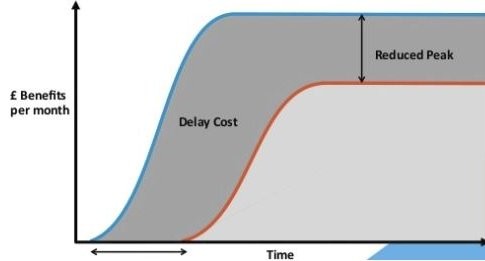 Your engineering team’s product launch date just slipped a week. Should you spend $20,000 on an outside engineering service to get the release back on schedule? In these situations, making the right decision quickly requires reliable information and analysis.
Your engineering team’s product launch date just slipped a week. Should you spend $20,000 on an outside engineering service to get the release back on schedule? In these situations, making the right decision quickly requires reliable information and analysis.
As more and more development companies feel the pressure to shorten product launch dates, the cost of delay becomes more real. However, in our podcast below, you’ll learn how development organizations frequently low-ball the true cost of even the most minor delays.
Roddi Simpson, CEO and Founder of Viozel, believes knowing how to quickly quantify the true cost of delayed time to market will help you make better decisions faster.
Listen in on our podcast where Roddi and SPK CEO Chris McHale discuss why realistically calculating the cost of delay is “the golden key that unlocks many doors.”
At SPK, we realize every development organization facing tough deadlines must balance engineering realities with delayed release costs. What are your challenges? We offer standard complimentary one-hour product development consultations with experienced SPK managers. To schedule a call to discuss your challenges and goals, just email us at info@spkaa.com and we’ll take it from there.
Next Steps:
- Learn how Roddi’s “Cost of Delayed Time to Market” model works.
- Suggest a follow-up topic for Chris and Roddi to discuss in their next podcast.
- Subscribe to our blog to stay informed on product development and engineering efficiency topics.
- Schedule a free consultation with a member of the SPK and Associates today.
- Browse the podcast’s transcript below.
Transcript:
Chris: Hi, this is Christine McHale with SPK Associates, and I am here today with Roddi Simpson who is the Founder and CEO at Viozel. And we are going to talk about an interesting topic for all of us engineers which is quantifying delayed time to market and how much that’s really costing our development organization which is a very, very hot topic I think these days particularly when there’s a shortage of engineers and everybody’s trying to get product to market as quickly as possible. So, Roddi, welcome and thanks for taking the time to join us.
Roddi: Thank you very much, I appreciate speaking with you.
Chris: So, before we get going on the topic tell us a little bit about Viozel and what you guys do. I was really interested to find you and we’re interested in knowing a little bit more.
Roddi: Sure, so after about 17 years working in research and development developing medical devices for top corporate device manufacturers, one of the things that I came up against again and again were supplier and sourcing challenges that were causing more headaches than they really should. And whether it was finding the right supplier for a very specific need or subsequently developing the process or bringing the technology to a point where it could be included in a product it seemed that a lot of things were being solved once they became a problem and that there really seemed to be an opportunity to connect better earlier with suppliers who ultimately, would be the solution to the problem.
But if we could avoid the problem in the first place and connect using technology that’s available today with really the best suppliers, then that would be something that could really help make the process of bringing new medical devices and products to market much more efficient and really add some value.
Chris: We totally understand that at SPK I’ve seen that. We’ve been working in the medical device industry for about 20 years now and our own purpose, of course, is to…for those who don’t know what we do it’s to make the business of product development more efficient and hopefully, more fun with introducing a nanogene, a really smart information technology along with improved processes. And so we’ve seen this challenge that you’re talking about regarding suppliers, and also elsewhere in engineering.
And these days in particular with the complexity of the products in medical device, it’s truly challenging. And there seem to be so many opportunities hidden away [SP] unfortunately. So, on that note, let’s actually talk a little bit about your recent efforts to quantify some of this delay and help our listeners out there understand what it’s actually costing. Everybody talks about product delay, it’s hard to get a handle on, “Well, what does that really mean from a numbers perspective?”
And so I personally was very enthusiastic to find your calculator out there. But first, before we get to that, let’s talk a little bit about client feedback. I mean, were there specific things that were told to you through your 17 years of experience that said to you, “Wow, I think there needs to be something very concrete to help people quantify this.” Or did you just have that idea in the middle of the night one night? What prompted it?
Roddi: Well, I think the real sort of thing that crystalized the need for it was in developing Viozel in order to solve issues with bringing products to market quickly, in order to describe the value proposition and to really show the value of the service, it pushed me to really look at, you know, how is this quantified. And at that point, I remember during my time specifically at J&J, there was all this pressure to get to market fast, and there was excellent training.
And the basic consent of unrecoverable sales due to a late launch was really well-understood and taught. But still with a specific value to assign decision-making could be quite hard and highly subjective where you could quite easily have lots of different opinions weighing pros and cons, and without a specific number to assign it would make the decisions difficult. So, I started doing some research, and I want to start with just finding the graph of sales per month versus time on the market where there’s a classic graph that shows what the impact of a delay in time to market is. And I discovered some very, very interesting work that has been done. And I decided to write a blog post which I published to LinkedIn, and then based on the response to that I decided to create a sort of basic general calculator that people can use in order to calculate that actual delay in time to market.
Chris: It’s interesting to me because we have this delay of product release always in our mind as well and we’re working with our clients and helping the people that we help. And yet we’ve always appreciated it more from the cost perspective of, “Well, if you’re delaying and there’s that much more product development and engineering resource and whatnot that needs to be done, what all the costs associated with that.” But we never jumped over into that delay to time to market area which is really the more important one I think I mean because that lost revenue can be very, very large and so your calculator I think is incredibly helpful personally speaking.
Roddi: Yeah, it’s massive. I was shocked because I think just intuitively as an engineer you haven’t been to business school, you haven’t seen a lot of the sort of background that goes into all the finance and so on, and even with some training I think there’s sort of just a natural thought where we’re late by a week to market, then how many would we have sold in that time? A handful perhaps, not many, you know, because was just getting started.
And only when you dig into it and you see that any week that you delay in going onto the market is a week that you delay reaching peak sales, and so you’re actually losing a week of peak sales, and so at that point, in the example I’ve given in my LinkedIn blog is if you have an annual peak sale of say $50 million and a profit margin of 30% and maybe a development team burn rate of 150K then the cost of delay of a month Is $1.4 million or $350,000 a week.
Chris: And that’s amazing.
Roddi: Yeah.
Chris: I would just really encourage all our listeners to…it’s hard to talk about this and visualize it, I would really encourage everybody to go to Roddi’s website which by the way is Viozel, viozel.com. And if you click over on resources, I think, the calculator, right, Roddi is one of the first things up there that you can look at
Roddi: Yeah, it’s right there.
Chris: And you can plug in some numbers and/or just take a look at this and visualize it for yourself because it’s quite impactful. One other question, Roddi, you described the cost of delay as that is the key thing, right, in your article or your blog. Do you think it’s always been this important and this impactful or do you think it’s more important these days in the era of continuous delivery and this squeezing of time to market and the squeezing down of the actual lifecycle of a particular product? What do you think about that? Is it more important today?
Roddi: Yes, I think it is. I think you’re absolutely right. I think that the lost value impact, the underlying equation, the underlying impact of being late to market is exactly the same and the mechanism is exactly the same, but I think it becomes more and more important as markets become more competitive, companies become more competitive, and as everyone is developing more and more efficient systems and learning how to get to market faster and faster and that competition increases, then anything that people can do to gain an advantage and a competitive edge is something that really helps. And I think one of those things is to be able to make good decisions. Do we spend another few weeks trying to find a cheaper vendor for the tooling investment? And a lot of engineers would spend an extra two weeks to save $10,000 or $20,000. Like, that seems like a lot of money when you’re just thinking about it. Making of good decisions on a timely basis is another thing that can help you get to market faster.
Chris: Right. Yeah, we noticed the same thing. And all of us being engineers we tend to be oriented towards the details of how much things cost and the specific details. So, that $10,000 or $20,000 seems like a lot of money until you put it into perspective as your calculator, your article did. We run into the same problem also at SPK because all of the work that we’re doing is for engineering or product development group, and we’re constantly trying to find ways to shorten that product lifecycle, make the engineers more efficient, free them up to really focus just on design and the things that they’re fantastic at by either introducing or managing the information technology, the systems, the applications and so on that will make them incredibly creative and productive, and so this constant discipline if you will of keeping the lifecycle short and really helping people get the product out the door we’re very cognizant of that and it motivates and kind of guides the things that we do every day.Well, that is just a great overview of the tool Roddi, and how people can educate themselves on this. So, again, I’d encourage everybody to take a look at it and try it out for yourself and see what it tells you, and as Roddi just mentioned, the more engineers are aware of that delayed cost I think the better because it guides our decision-making, all of us in a better way. So, thanks again, Roddi, I really appreciate it. I appreciate your time and hopefully, we can have another conversation soon.
Roddi: You’re welcome. Thank you very much, Chris. It’s always a pleasure talking to someone that shares a passion for bringing medical products to market fast.







